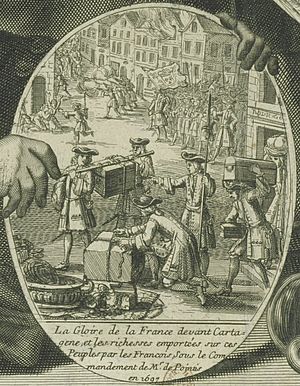Raid on Cartagena de Indias (1697) facts for kids
The Raid on Cartagena de Indias was a big attack by the French on the strong city of Cartagena de Indias. This happened on May 6, 1697. It was part of a larger conflict called the War of the Grand Alliance.
Contents
Why the French Attacked Cartagena
By 1695, the French Navy was not as strong as the navies of England and the Netherlands. Because of this, the French started using a different tactic. They focused on "privateering," which meant using private ships to attack enemy ships and cities. This was a way to hurt their enemies and gain wealth.
A French commander named Bernard Desjean, Baron de Pointis was active in the Caribbean. He convinced King Louis XIV of France to let him try a bold attack. His target was Cartagena, which was known as one of the richest cities in the region. Today, Cartagena is in Colombia.
The Attack on Cartagena
Pointis was given command of a fleet of seven large warships, three smaller frigates, and other vessels. His fleet left Brest, France, on January 7, 1697. They arrived in Saint-Domingue (now Haiti) in the West Indies on March 3.
Pointis asked for help from Governor Jean du Casse. Du Casse agreed to help, even though he wanted to attack a different city, Portobelo. About a month later, Pointis's fleet reached Cartagena. It included 1,200 soldiers and 650 buccaneers. Buccaneers were like pirates who often worked with governments.
Cartagena had strong defenses, but they were not as good as they used to be. Pointis's forces captured the two main forts defending the city quite easily. They lost only about sixty men. From May 6 to May 24, the French forces took many valuable things from the city. They gathered loot worth a huge amount of money, estimated at ten to twenty million livres.
After the raid, Pointis sailed directly back to France. He did not share the treasure with his buccaneer allies as he had promised.
What Happened After the Raid
On his way back to France, Pointis managed to avoid the English admiral John Nevell. Nevell's fleet had been sent from Cadiz, Spain, to chase the French. After a three-day chase, Nevell only captured one French ship.
Unfortunately for Nevell, this ship was a hospital ship. It was carrying sick sailors with yellow fever. The disease quickly spread through the English and Dutch fleets. This terrible illness killed 1,300 English sailors, six captains, and Admiral Nevell himself. Only one captain in the Dutch fleet survived the outbreak.
The French fleet also suffered from yellow fever. Hundreds of their sailors died from the disease. However, Pointis made it back to France safely. He gave King Louis XIV his share of the loot, which was two million livres. The rest of the treasure made Pointis an extremely wealthy man.
The next year, Pointis published a book about his journey. It was called Relation de l'expédition de Carthagène faite par les François en 1697.
See also
 In Spanish: Expedición de Cartagena (1697) para niños
In Spanish: Expedición de Cartagena (1697) para niños
- Sancho Jimeno de Orozco


